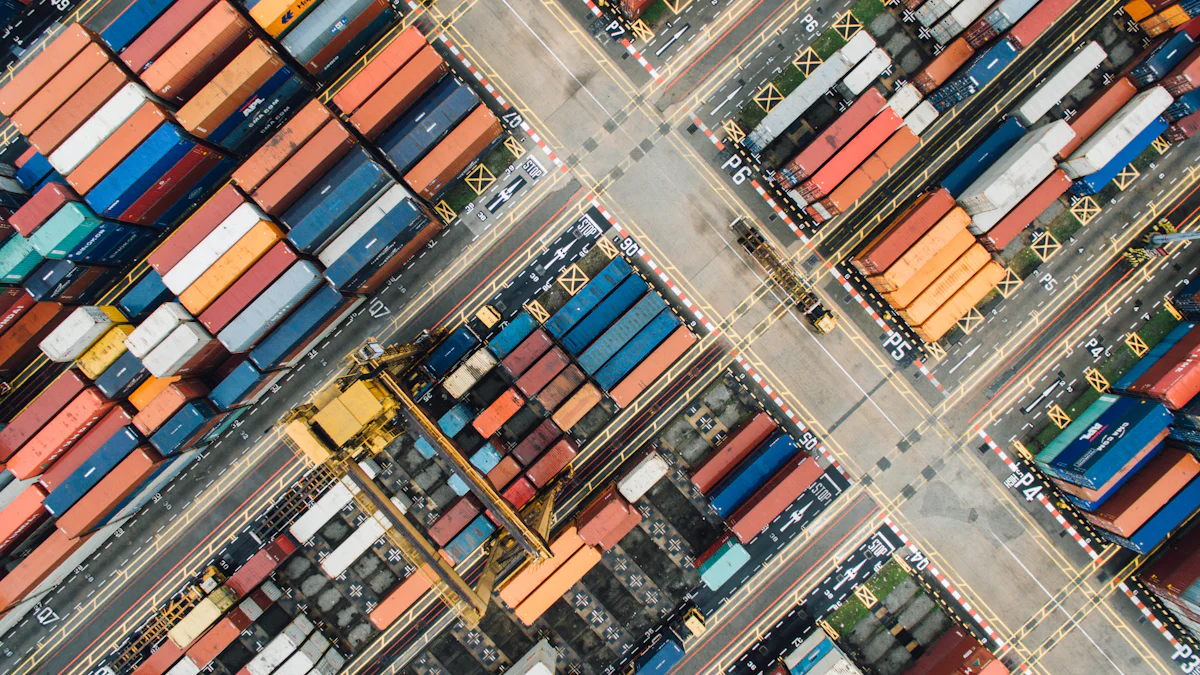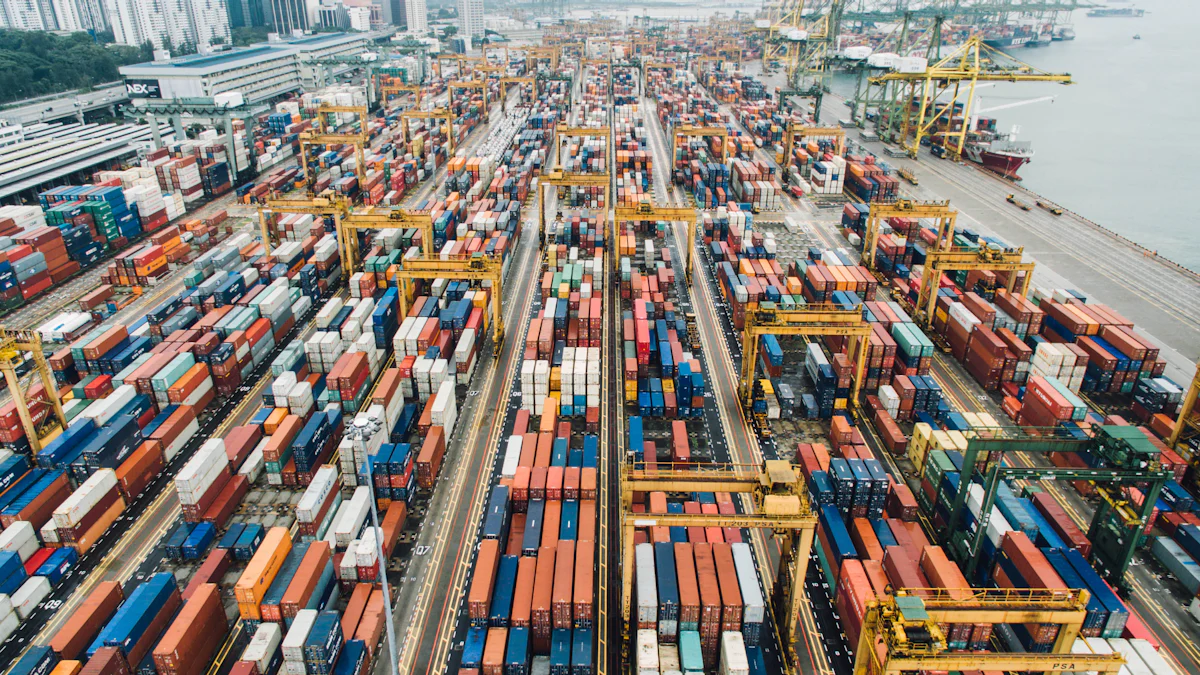Agility and Resilience in the logistics industry and supply chain

The logistics industry faces constant challenges, from the covid-19 pandemic to current supply chain risks like geopolitical tensions and natural disasters. To stay competitive, you need an agile and resilient supply chain. Agility means adapting quickly to changes without sacrificing quality or cost. Resilience ensures you recover fast from disruptions.
Term | Definition |
|---|---|
The ability to respond efficiently to fluctuations in consumer demand and market vulnerabilities without sacrificing cost or quality. | |
Supply Chain Resilience | The ability to adapt to structural changes by modifying supply chain strategies, products, and technologies to sustain unexpected shocks and disturbances. |
Innovative tools like JUSDA's JusLink help you tackle supply chain disruptions with smarter strategies and real-time insights.
Key Takeaways
Agility helps your supply chain adjust fast to changes. This keeps you competitive and meets customer needs quickly.
Resilience helps your supply chain bounce back from problems. It lets you succeed even during tough times.
Using tools like JusLink improves teamwork and tracking. This helps you make smart choices and avoid risks.
Understanding Supply Chain Agility and Resilience

Defining Supply Chain Agility
Supply chain agility is all about flexibility. It’s your ability to adapt quickly when demand spikes or supply chain disruptions occur. Think of it as being light on your feet—ready to pivot when the market shifts. For example, agility means adjusting production schedules or rerouting shipments without missing a beat.
Key performance indicators (KPIs) can help you measure agility. Here are a few:
KPI | Description |
|---|---|
Inventory turnover | Tracks how often you sell and replace inventory. Higher rates show better agility. |
Lead time | Measures how fast you respond to market changes. Shorter times mean greater efficiency. |
Order accuracy | Reflects how well you manage inventory and meet customer expectations. |
Supplier performance scorecards | Evaluates supplier reliability and delivery times to identify bottlenecks. |
Cash-to-cash cycle time | Shows how quickly you turn resources into cash. Faster cycles indicate agility. |
When you focus on agility, you stay ahead of competitors by responding faster to market demands.
Defining Supply Chain Resilience
Resilience is your ability to bounce back when disruptions hit. It’s not just about surviving a crisis—it’s about thriving afterward. A resilient supply chain combines strength and flexibility. You can adapt to structural changes, like shifting sourcing strategies or adopting new technologies, to handle unexpected shocks.
What makes a supply chain resilient? Here are some key traits:
Safety stock policies to manage inventory.
Diversified sourcing to reduce risks.
Flexible logistics networks for quick adjustments.
Robust IT systems for real-time data analysis.
Risk management strategies to prepare for disruptions.
Resilience ensures you’re ready for anything, from natural disasters to geopolitical tensions.
Real-World Examples of Agility and Resilience in the Logistics Industry
Let’s look at how companies have successfully implemented these strategies. Apple is a great example of supply chain agility. By diversifying its manufacturing partners, Apple quickly adjusted production when disruptions occurred. In 2012, they even redesigned an iPhone component shortly before launch, relying on Foxconn’s flexibility to scale production.
On the resilience side, the COVID-19 pandemic highlighted the importance of robust supply chains. Many companies reevaluated their strategies, moving away from single-source suppliers to more diversified networks. This shift helped them adapt to global challenges and maintain operations during the crisis.
By combining agility and resilience, you can build a supply chain that’s both flexible and durable—ready to handle whatever comes your way.
Key Challenges in Building Agility and Resilience
Limited Supply Chain Visibility
You can’t fix what you can’t see. Limited visibility is one of the biggest supply chain challenges businesses face today. Without a clear view of your operations, it’s hard to predict disruptions or respond effectively. Common issues include:
Losing control over inbound supply networks.
Struggling with supply and demand management.
Carrying excess inventory due to poor demand forecasting.
When you lack end-to-end visibility, you’re left guessing instead of making informed decisions. Tools like JusLink can help by providing real-time insights and improving transparency across your supply chain.
Fragmented Data and Disconnected Systems
Data is powerful—if you can use it. Fragmented data makes decision-making a nightmare. You might have tons of information, but disconnected systems prevent you from turning it into actionable insights. This leads to inefficiencies, higher costs, and even a poor customer experience.
For example, if your logistics team can’t access accurate inventory data, shipments might get delayed. That’s why integrating your systems is crucial. Platforms like JusLink bring everything together, helping you streamline operations and reduce disruptions.
Resistance to Change in Traditional Logistics Operations
Change is hard, especially in industries rooted in tradition. Many logistics teams resist adopting new technologies or processes. This resistance slows down progress and leaves you vulnerable to disruptions.
You might hear concerns like, “We’ve always done it this way.” But sticking to outdated methods won’t help you stay competitive. Embracing innovation, like AI-driven tools or cloud-based platforms, can make your supply chain more agile and resilient.
Complexities in Global Supply Chain Networks
Managing a global supply chain is no small feat. You deal with geopolitical risks, economic fluctuations, and sustainability concerns. Shipping delays and overreliance on single suppliers add to the chaos.
The just-in-time production model, while efficient, leaves little room for error. If one link in the chain breaks, the entire system suffers. To navigate these complexities, you need flexible strategies and increased visibility. Advanced platforms like JusLink can help you adapt to market changes and maintain smooth operations.
Strategies to Enhance Supply Chain Agility and Resilience
Leveraging Digital Transformation Tools like JusLink
Digital transformation is a game-changer for supply chains. Tools like JusLink empower you to adapt quickly to market changes while staying efficient. They provide real-time insights into supplier performance, helping you make informed decisions. Technologies like IoT and AI enhance tracking and forecasting, while blockchain ensures secure and traceable transactions. Automation streamlines processes like inventory management, reducing errors and speeding up workflows. By embracing these tools, you can improve efficiency, boost transparency, and stay ahead of disruptions.
Improving Data Visibility and Real-Time Monitoring
Real-time visibility is essential for enhancing supply chain agility. When you have access to live data, you can respond faster to demand fluctuations or unexpected delays. For example, real-time analytics give you a clear view of your supply chain, enabling quick adjustments to production or inventory levels. Platforms like JusLink allow you to track shipments, monitor supplier performance, and even halt incoming orders when demand drops. This level of transparency keeps you competitive and prepared for any challenge.
Fostering Collaboration Across the Logistics Industry
Collaboration is key to building a resilient supply chain. When stakeholders share data and communicate effectively, decision-making becomes faster and more accurate. This reduces delays and optimizes processes. Collaboration also enhances transparency, giving everyone a clear view of inventory levels and potential disruptions. Plus, it fosters trust and stronger relationships among partners. By working together, you can create a more sustainable and efficient supply chain.
Conducting Risk Analysis and Scenario Planning
Risk analysis helps you prepare for the unexpected. Best practices include using multiple suppliers, sourcing closer to your operations, and building inventory buffers. Regular stress tests identify vulnerabilities, while predictive analytics forecast potential disruptions. For example, JusLink’s intelligent risk management system monitors risks in real time, enabling swift responses. By planning for different scenarios, you can minimize the impact of supply chain disruptions and maintain smooth operations.
Utilizing Advanced Technologies for Dynamic Simulation and Stress-Testing
Advanced technologies like digital twins and AI take stress-testing to the next level. Digital twins create virtual replicas of your supply chain, allowing you to simulate scenarios and predict outcomes. AI and machine learning analyze large datasets to optimize inventory and forecast trends. Predictive analytics use historical data to anticipate disruptions with greater accuracy. These tools help you identify weak points and strengthen your supply chain before issues arise.
Benefits of Agility and Resilience in the Logistics Industry

Enhanced Operational Efficiency and Cost Savings
When your supply chain operates efficiently, you save time and money. Agility helps you optimize inventory levels, reduce waste, and streamline processes. For example, by using tools like JusLink, you can monitor real-time data and adjust operations instantly. This reduces delays and eliminates unnecessary costs. Resilience plays a role too. It ensures you’re prepared for unexpected shocks, like supplier disruptions or transportation delays. By prioritizing resiliency, you minimize downtime and keep your operations running smoothly. Together, agility and resilience create a leaner, more cost-effective supply chain.
Competitive Advantage in a Dynamic Market
In today’s fast-paced logistics industry, staying ahead of the competition is crucial. Agility gives you the ability to adapt quickly to market changes. You can meet evolving customer needs and seize new opportunities faster than your competitors. During crises, agile companies respond swiftly, maintaining their market position while others struggle. For instance, Amazon’s flexible supply chain allowed it to adapt during the pandemic, ensuring uninterrupted service. By embracing agility, you position yourself as a leader in a dynamic market.
Improved Customer Satisfaction and Retention
A resilient supply chain ensures your customers get what they need when they need it. Consistent product availability and timely deliveries build trust and loyalty. When you can adapt to changing preferences, you exceed customer expectations. For example, JusLink’s intelligent risk management system helps you avoid delays and shortages, ensuring a seamless experience for your customers. By focusing on resilience, you not only meet expectations but also strengthen relationships with your customers.
Case Studies Highlighting Success with JUSDA's Solutions
Here’s how companies have leveraged innovative solutions to enhance agility and resilience:
Apple: Diversified its supplier base and used advanced software for better visibility.
Toyota: Adopted just-in-time production and a culture of continuous improvement.
Amazon: Integrated robotics and flexible systems to adapt during disruptions.
Company | Innovative Solution | Outcome |
|---|---|---|
Pharmaceutical Company | Scenario planning and Monte Carlo simulation | Improved agility and reduced compliance risks |
Automotive Manufacturer | Digital twins and cyber resilience testing | Mitigated risks and boosted production efficiency |
These examples show how agility and resilience can transform supply chain management, helping businesses thrive in challenging environments.

JUSDA Solutions
To provide you with professional solutions and quotations.
Agility and resilience are your keys to navigating supply chain disruptions. They reduce costs, improve customer satisfaction, and help you adapt to market changes.
Benefit | Description |
|---|---|
Increased Agility | Respond quickly to customer demand and market changes. |
Reduced Lead Time | Streamline inventory management for faster deliveries. |
Decreased Costs | Eliminate waste and inefficiencies to save money. |
Enhanced Risk Mitigation | Identify risks early and create contingency plans. |
Improved Customer Satisfaction | Meet expectations and adapt to changing preferences. |
JUSDA’s JusLink empowers you with real-time insights, risk management, and seamless collaboration. Start by defining your objectives, assessing your supply chain, and aligning teams. With the right tools, you’ll stay competitive and ready for anything.
See Also
Transforming Logistics Through Innovative Supply Chain Solutions
The Future of Logistics: AI in Supply Chain Management
The Importance of Security in Supply Chain Logistics
